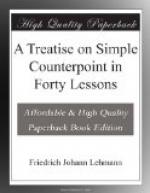The suspension may now be a quarter-note, or its rhythmic equivalent. It then comes on the first (a) or third (b) quarter of the measure, and the resolution on the quarter following. The preparation should be as long as, or longer than, the suspension. [Fig. 153.]
[Illustration: Fig. 153.]
The eighth-note as in Fig. 154_a_ is good. It should be used only on the second half of a weak beat, and be preceded by a dotted quarter-note. Sixteenth-notes may be used in place of the eighth-note, but should be approached and left step-wise. [Fig. 154_b_.]
[Illustration: Fig. 154.]
The first species may be employed occasionally in the course of an exercise.
Make plentiful use of imitation.
When more than one line of a choral is used, it may be treated by having the other parts continue through the holds, as at a, or letting them rest, as at b. [Fig. 155.]
When, in place of the hold, the movement continues, it is necessary to interpolate a full measure in place of the hold. [Fig. 155 and Fig. 159.]
[Illustration: Fig. 155.]
The note under the hold may be continued the extra measure, or the part may rest and then reenter. All that is required is that it begin after the lapse of one measure, i.e., when the line ends on the accent the next line begins on the weak beat of the measure following, and if it ends on the weak beat then on the accent of the next measure.
The interval at any hold except the last of a choral may be either a perfect (a) or imperfect consonance (b). [Fig. 156.]
[Illustration: Fig. 156.]
Modulation often occurs at the holds. If so, make it clear.
In this and in succeeding lessons set the cantus firmus in any part, and transpose if necessary.
EXERCISES
To cantus firmus b write two counterpoints above and two below.
To cantus firmus a write one above and one below, with both parts resting at the hold. Also do the same with the counterpoint continuing at the hold. [Fig. 155_a, b._]
CANTI FIRMI
[Illustration: Fig. 157.]
LESSON XXXIV
FREE HARMONIZATION IN THREE-PART COUNTERPOINT
When writing in three or more parts, it is well to let a part rest occasionally, and, when it reenters, have it imitate one of the other parts. [Fig. 158.]
[Illustration: Fig. 158.]
EXERCISES
To cantus firmus a write two counterpoints above and two below in two-part counterpoint.
Write two original eight-measure phrases in two-part counterpoint.
To cantus firmus b write one example in three-part counterpoint with continuous movement at the hold. [Fig. 159.]




